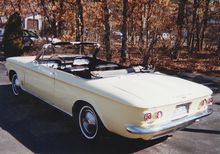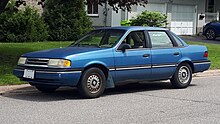
Minivan is a car classification for vehicles designed to transport passengers in the rear seating row(s), with reconfigurable seats in two or three rows. The equivalent classification in Europe is MPV or M-segment - and are taller than a sedan car, hatchback, SUV or station wagon.

A pickup truck or pickup is a light or medium duty truck that has an enclosed cabin, and a back end made up of a cargo bed that is enclosed by three low walls with no roof. In Australia and New Zealand, both pickups and coupé utilities are called utes, short for utility vehicle. In South Africa, people of all language groups use the term bakkie; a diminutive of Afrikaans: bak, meaning bowl or container.

The AMC Gremlin is a subcompact automobile introduced in 1970, manufactured and marketed in a single, two-door body style (1970–1978) by American Motors Corporation (AMC), as well as in Mexico (1974–1983) by AMC's Vehículos Automotores Mexicanos (VAM) subsidiary.
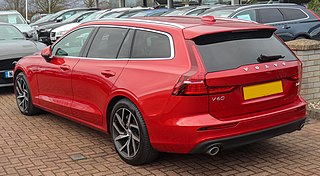
A station wagon or estate car is an automotive body-style variant of a sedan with its roof extended rearward over a shared passenger/cargo volume with access at the back via a third or fifth door, instead of a trunk/boot lid. The body style transforms a standard three-box design into a two-box design—to include an A, B, and C-pillar, as well as a D-pillar. Station wagons can flexibly reconfigure their interior volume via fold-down rear seats to prioritize either passenger or cargo volume.

American Motors Corporation was an American automobile manufacturing company formed by the merger of Nash-Kelvinator Corporation and Hudson Motor Car Company on May 1, 1954. At the time, it was the largest corporate merger in U.S. history.

Rambler is an automobile brand name that was first used by the Thomas B. Jeffery Company between 1900 and 1914.

A hatchback is a car body configuration with a rear door that swings upward to provide access to the main interior of the car as a cargo area rather than just to a separated trunk. Hatchbacks may feature fold-down second-row seating, where the interior can be reconfigured to prioritize passenger or cargo volume.

Nash Motors Company was an American automobile manufacturer based in Kenosha, Wisconsin from 1916 until 1937. From 1937 through 1954, Nash Motors was the automotive division of Nash-Kelvinator. As sales of smaller firms declined after 1950 in the wake of the domestic Big Three automakers’ advantages in production, distribution, and revenue, Nash merged with Hudson Motors to form American Motors Corporation (AMC). Nash automobile production continued from 1954 through 1957 under AMC.

The Hudson Motor Car Company made Hudson and other branded automobiles in Detroit, Michigan, U.S., from 1909 until 1954. In 1954, Hudson merged with Nash-Kelvinator to form American Motors Corporation (AMC). The Hudson name was continued through the 1957 model year, after which it was discontinued.
Governments and private organizations have developed car classification schemes that are used for various purposes including regulation, description, and categorization of cars.

In the automotive industry, rebadging is a form of market segmentation used by automobile manufacturers around the world. To allow for product differentiation without designing or engineering a new model or brand, a manufacturer creates a distinct automobile by applying a new "badge" or trademark to an existing product line.

Captive import is a marketing term and a strategy for a vehicle that is foreign-built and sold under the name of an importer or by a domestic automaker through its own dealer distribution system.

A crossover, crossover SUV, or crossover utility vehicle (CUV) is a type of automobile with an increased ride height that is built on unibody chassis construction shared with passenger cars, as opposed to traditional sport utility vehicles (SUVs), which are built on a body-on-frame chassis construction similar to pickup trucks.

Subcompact car is a North American classification for cars smaller than a compact car. It is broadly equivalent to the B-segment (Europe), supermini or A0-class (China) classifications.
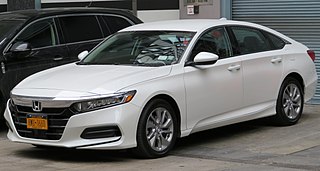
Mid-size—also known as intermediate—is a vehicle size class which originated in the United States and is used for cars larger than compact cars and smaller than full-size cars. "Large family car" is a UK term and a part of the D-segment in the European car classification. Mid-size cars are manufactured in a variety of body styles, including sedans, coupes, station wagons, hatchbacks, and convertibles. Compact executive cars can also fall under the mid-size category.

Full-size car—also known as large car—is a vehicle size class which originated in the United States and is used for cars larger than mid-size cars. It is the largest size class for cars. In the United Kingdom, this class is referred to as the executive car, while in Europe, it is known as E-segment or F-segment.
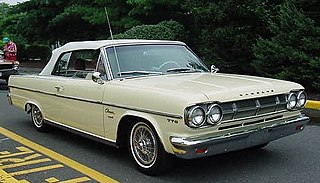
The Rambler Classic is an intermediate-sized automobile built and marketed by American Motors Corporation (AMC) from the 1961 through 1966 model years. The Classic replaced the Rambler Six and Rambler Rebel V8 names, which were retired at the end of the 1960 model year.

The Nash Rambler is a North American automobile that was produced by the Nash Motors division of Nash-Kelvinator Corporation from 1950 until 1954 in sedan, wagon, and fixed-profile convertible body styles.
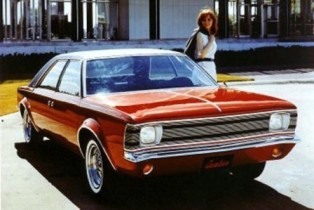
The AMC Cavalier was a compact concept presented by American Motors (AMC) in 1965, noted for symmetrical elements of its design and its interchangeable body parts.

The XR-400 was a fully operational concept car. A "sporty" youth-oriented convertible was built in 1962 by the Budd Company, an independent body builder in Detroit, Michigan, for evaluation by the fourth largest U.S. automaker at the time, American Motors Corporation (AMC).




